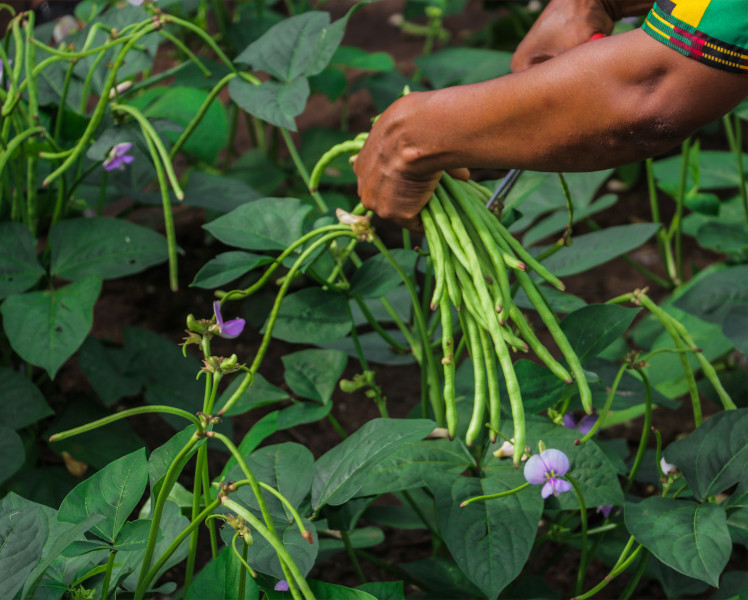
Building a food secured Africa

Every farmer’s desire is to produce crops that will be presentable, fresh or near to fresh (depending on when it gets to the market), attractive to the market and sustainability in production. This in turn dictates the quality of sales as well as profit made at the long run. Harvesting requires carefulness and detailing in order not to damage the growing vines or to keep the plant alive and active to produce more. Because most crops are fragile, especially vegetables and are perishable, it is advised necessary precautions are taken to ensure produce are taken to the market as fresh or rather as safe as possible. This is vital as it will not only affect sales, it will also affect the shelf life of the crops, profitability and safety for consumption. Hence, developing certain habits that will ensure quality, germ free farm produce are taken to the end users. This will impact extended shelf-life of farm produce as well as promote food security.
Harvesting can be done in many ways depending on the type of crop grown and the available technology to perform the activity. It can be done by the use of hands, tools, simple or complex machines. This article will focus on harvest of fruits and vegetables because they are fragile in nature and have short shelf life. The way crops in this category are handled at harvesting, necessary post-harvesting treatments, packing/packaging and transporting them has a level of impact on their value. The understanding of time to harvest some vegetables in order to maintain continuous production, keep their flavor, ensure palatability and prolonged shelf life is also a thing to consider. Therefore, we can begin to outline some vital practice we need to avoid during harvest to keep our crops safe for consumption and our plants healthy to produce more.
Plants want to keep producing more at the time of harvest. When you don’t harvest on time, the plant will stop producing. Knowing when to harvest will not only keep you in production, it will also help you preserve the flavor and nutrients of the crop. Vegetables like green beans, peas at their peak of taste and nutrition when tender and immature whereas, tomatoes, some varieties of pepper need to completely ripe on the vine so that their flavor can become fully developed.
Handling our crops with care is very important. Therefore, we must avoid forcefully detaching a vegetable from the plant. This can damage the plant and create an avenue for infectious disease to set in. when the weather is wet, avoid working among vegetables in order not to spread fungal and other diseases among plants. When cucumber or tomatoes begins to fruit, the weight of the fruits will create tension on the vines. Ensure you keep increasing your support system so that your plants won’t bend or break. This can hamper production.
Understanding the perfect condition to harvest vegetables also matters. Avoid harvesting vegetables especially leafy vegetables in the heat of the day because they tend to wilt almost immediately. The quality of vegetables (nutrients, crispiness, taste and flavor) is at its highest at the time of harvest and begins to decrease rapidly afterwards. The best time to harvest most vegetables is in the early morning after the dew dries off.
You don’t want your product to spoil before getting to the market so ensure fruit vegetables don’t fall off or crack while harvesting. Cracks reduce the quality of the crop and such opening can be an entry for germs which may contaminate the crop. When a fruit falls to the ground or hit each other as a result of throwing it forcefully in the harvest basket or rack, mechanical injury occurs and can render it susceptible to spoilage. Avoid packing them together but select them out.
The ability to sort, grade and package them well for transportation to the market is very important. Avoid packing both cracked and whole fruits together. Remember you want to take a good product to the market and make profit also, so proper care needs to be observed.
Using an appropriate tool to harvest your produce is vital too. This will not only give your crops good appearance but also helps the plant remain intact. Crops like cucumber, watermelon, eggplants, pepper etc. can be carefully twisted and plucked or use sharp knife/hand pruners. Crops like lettuce, kale, peas can either be pinched or snapped off gently with the finger. Vegetables that don’t easily separate from the plant should be cut off. You can use dedicated scissors to snip off beans.
Lastly, hygienically pack your produce to render it safe for consumption. Ensure you care for your plant immediately after each harvest to keep it in shape for the next batch. When we begin to appropriate the right principles during harvest, we will take control over most challenges encountered in preserving our produce and rendering it safe for consumption.